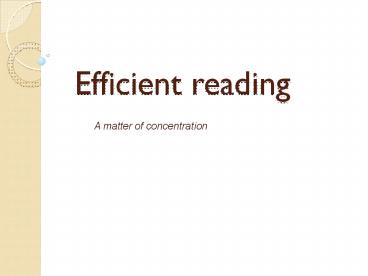Efficient reading - PowerPoint PPT Presentation
Title:
Efficient reading
Description:
Efficient reading A matter of concentration Concentration Imagine driving a car at 20 kilometers per hour vs. driving at 200 kilometers per hour. – PowerPoint PPT presentation
Number of Views:255
Avg rating:3.0/5.0
Title: Efficient reading
1
Efficient reading
- A matter of concentration
2
Concentration
- Imagine driving a car at 20 kilometers per hour
vs. driving at 200 kilometers per hour. - Reading is the same.
- Concentration requires energy
- Health, rest, physical mental well-being are
all important. - Rest breaks are important
- Rewards are important
3
How fast should you read?
- Native English Speakers
- 250 wpm with 70 comprehension for average adult
- 300 wpm with 70 comprehension for college
students
4
Distractions
- External
- People talking
- Telephone
- Music
- Internal (more difficult to control)
- Thoughts
- Other things you need to do
- Mind wandering
5
Increasing Reading Speed
- Be Aggressive
- Be active.
- Look for Meaning.
- Drive for the main idea.
6
Increasing Reading Speed
- Concentrate
- Focus on Meaning.
- Consider Your Purpose.
- Be attentive.
- Visualize (use imagination and five senses)
7
Increasing Reading Speed
- Stop Regressions
- Regressions are when you reread what you have
already read - Keep your mind from wandering.
- Pay attention during the first reading.
- Reread only when necessary such as when the
material is complex
8
Increasing Reading Speed
- Reduce Vocalization
- This is moving your lips when you read.
- Subvocalization is when you hear the voice in
your head. - Put a paper in front of your lips to see if it
moves. - You read with your mind, not your mouth.
- Subvocalization can be very helpful for difficult
and complex reading
9
Increasing Reading Speed
- Expand Fixations
- Identify Thought Units.
- Read in Phrases.
- Decrease Fixations.
10
Increasing Reading Speed
- Use a Pen as a Pacer
- Set a Rhythmical pace.
- Move the Pen from Left to Right.
- Make a Z Pattern with Return Sweeps.
11
Increasing Reading Speed
- Preview Before Reading
- Think About the Title.
- Look for Key Words and Phrases.
- Read the Boldface and Italic Type.
- Make Predictions.
- Decide What You Want to Learn.
- Activate Your Schema.
12
Increasing Reading Speed
- Set a Time Goal
- Estimate Words per Page.
- Calculate Projected Reading Speed.
- Pace Yourself.
- Make Your Goal Realistic.
13
Increasing Reading Speed
- Be Flexible
- Adjust Speed According to Purpose.
- Skim When Necessary.
- Slow Down for Difficult
- Material.
14
Increasing Reading Speed
- Practice
- Read Every Day.
- Practice Faster Reading Techniques.
- Be Willing to Try.
15
The Open, Window by Saki
16
Saki (1870-1916)
- Hector Hugh Munro
- or H. H. Munro
- British
- Born in Burma
- Joined Indian Imperial Police
- Fought and died in WW1 as an ordinary soldier
- Master of the short story
- Write about ironies of society
- A closet homosexual
- Read Tobermory
17
(No Transcript)
18
(No Transcript)
19
(No Transcript)
20
(No Transcript)
21
From a high school play based on this story.

